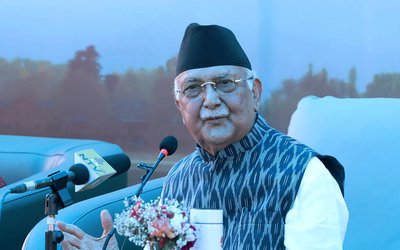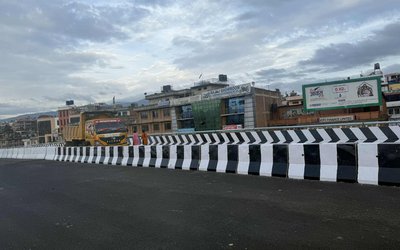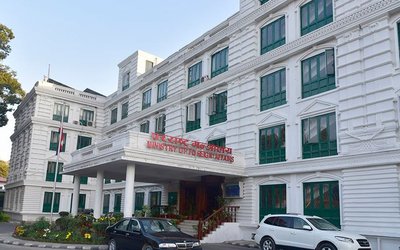More on News





If the recent trend of agriculture production is any indication, Nepal is definitely going to face a food crisis in the coming years. Acute shortage of fertilizers and prolonged drought during the plantation season are going to inflict a loss in the production, amounting to 563,000 tons of edible foods this year.
According to spokesperson of the Ministry of Agriculture Development Prabhakar Pathak, the production of paddy and maize is likely to fall by 14.2 percent and 10 percent respectively compared to the corresponding figures of last year.
This is the indication of the preliminary report on the food output for 2012/13.
The report suggests that the total paddy output is expected to drop by 720,000 tons this year compared to 5.07 million tons -- all time high production -- recorded last year. Likewise, maize production is anticipated to drop by around 164,000 tons due to insufficient rainfall during the farming season.
“This loss in production of paddy by 720,000 tons (or 432,000 tons of milled rice) and maize by 164,000 tons (131,000 tons in edible state) will eventually lead to a loss of 563,000 tons of net edible foods this year,” said spokesperson Pathak. Food demand will reach 5.3 million tons and the key producer districts reported less than 65 percent plantation and production area decline by 140,000 hectares.
According to the Ministry of Agriculture and Development, this loss in production of paddy and maize is serious.
Nepal is not alone to see the fall in the agriculture production due to shortage of fertilizer and rain. Other South Asian countries of the region are facing similar situations.
South Asian Experiences
South Asia has all kinds of potentials to produce enough food to meet the required demands of the population. Due to the high economic growth, rapid urbanization and liberalized trade, agriculture patterns in South Asia are shifting from merely a subsistence base to commercial production.
One of the major advantages of South Asia is the availability of water for irrigation and the climatic variations. Despite these benefits, one of the grim realities about South Asia is that the countries of the region are facing trouble in addressing the long term challenge to food security.
Experts discussed various papers presented at the regional workshop on Agricultural Policy in sub-Saharan Africa and South Asia, organized by the Global Development Network, an independent international organization registered in New Delhi. Papers were presented covering agricultural pricing and public procurement, irrigation and water use efficiency, improving the effectiveness, efficiency and sustainability of fertilizer use, managing agricultural commercialization for inclusive growth and addressing the long term challenges to food security and rural livelihoods.
“Investment in agriculture and rural livelihoods must be a priority for South Asia in order to meet the challenges of food insecurity in the coming years. Attention should be paid to financial investment, enabling small scale producers to participate in markets allowing them to manage risk more effectively,” said K.S. Kavi Kumar, professor at Madras School of Economics, in his research paper on addressing long term challenges to food security and rural livelihoods in South Asia.
“The studies undertaken by GDN have not focused on the uniqueness of Nepal’s experience in pro-poor commercialization of agriculture. However, the findings of the study will be relevant to cooperatives that have gone to a very high scale of commercialization, e.g. cooperatives in Sidhuwa of Dhankuta district,” said Bharat Prasad Upadhyaya, executive director of CEAPRED, taking part in the discussion.
“CEAPRED encourages the beneficiaries to form a cooperative, and usually phases out its interventions after the cooperatives are trained and made self-operating. This has been a sustainable way of ending the program.”
Nepalese officials attributed the drop in production prospects to severe shortage of chemical fertilizers during plantation season and long spell of drought along with insufficient irrigation facility in the fall of production in this session.
GDN researchers also held the view that the time has come to develop ways for efficient management of water and the need to make the availability of fertilizers during the paddy session. “Despite availability of various sources of water, large numbers of farmers still rely on the rain for their production. The time has come to take policy decision on water marketing,” said Dr. Ali Hasanain, Lahore University of Management Sciences, Pakistan, in his paper on Irrigation and water use efficiency.
The use of fertilizer is very nominal in South Asia, including Nepal. “The current pattern of use with heavy reliance on nitrogenous fertilizer coupled with poor nutrition management, lack of complementary inputs, declining soil fertility and weak marketing and distribution systems, “said Mustafa K. Mujeri, Bangladesh Institute of Development Studies, in his paper on Improving the Effectiveness, Efficiency and Sustainability of Fertilizer Use in South Asia.
“The paper focused on addressing the paucity of genuine developing country perspectives not only on global issues but even quintessentially the local development problems such as those related to agricultural and rural development,” said Tuhin Sen, lead strategist, Global Development Network.
“Designed as a policy research project, it seeks to enrich the body of knowledge related to agriculture issues. The research papers presented here explore innovative ways of bridging the research and policy gap,” said project director George Mavratas.
At a time when the countries of the region lack broad based agriculture policies and research, GDN’s research findings will help to formulate a long term policy on agriculture and food security.





